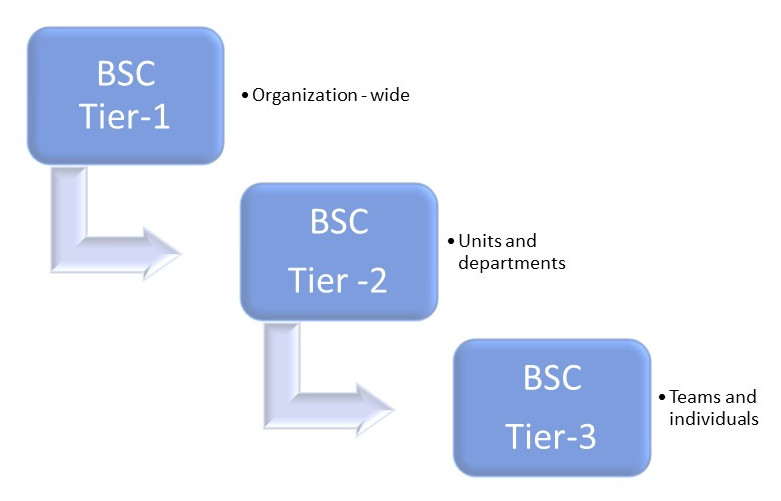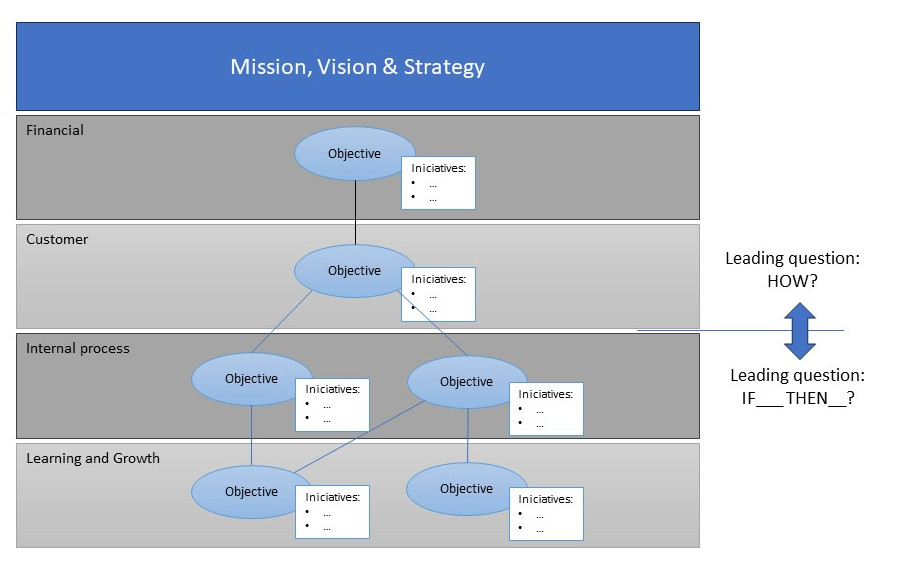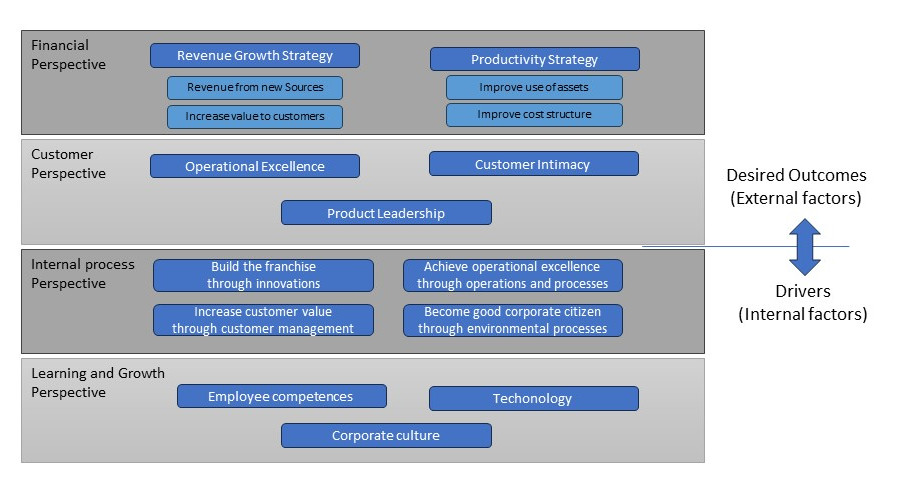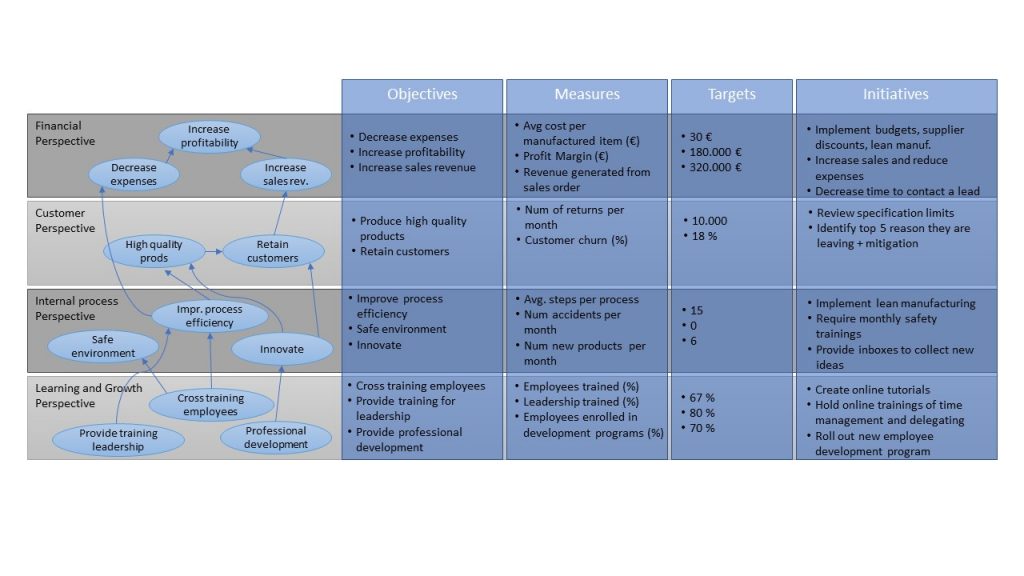When we define business strategies, it is sometimes difficult to communicate them to the rest of the teams and see their effectiveness in the company. Similarly, throughout the strategy journey, we will have to make important decisions, which should be backed up by data to help us make the best selection from among the different options. A strategy is only as good as its execution, and understanding it is key.
Dr. Robert Kaplan and Dr. David Norton are the fathers of two tools that will serve us for this purpose. The Balanced Scorecard will help us to control performance metrics and align them with the organization’s strategic objectives. On the other hand, Strategy maps will help us to complement the Balanced Scorecard by aligning the objectives of an organization with its initiatives and dependencies in a visual way. Because of their simplicity, strategy maps have become an indispensable part of strategic management for many organizations.
Let’s take a closer look at how these tools work and how they relate to each other.
Balanced Scorecard
We can say that the Balanced Scorecard (BSC) is a strategic management tool that provides a balanced view of an organization’s performance by considering a variety of different performance indicators (KPIs). It is a strategic asset that can guide an organization towards its long-term goals. Developed by Dr. Robert Kaplan and Dr. David Norton in the early 1990s, it has become the cornerstone of modern business strategy. Thanks to the BSC, organizations can:
- Communicate what they want to achieve.
- Align the work done on a day-to-day basis with the strategy.
- Prioritize projects, services and products.
- Measure and monitor progress towards strategic objectives.
- Maintain strategic focus while adapting to changing conditions.
It is called “balanced” because, until then, the way to measure and control organizations was done solely on a financial level. With this single-focused vision, there was no information on other basic aspects of the company, which ultimately also affect the economic level. The BSC gives us a much more holistic view of what is happening in the company and how an action affects different areas of the organization.

The BSC is built around four main perspectives:
- Financial metrics: these are the traditional measures of business success, such as revenue, profit margins and return on investment.
- Customer metrics: these focus on customer satisfaction, retention and market share.
- Internal Process Metrics: these metrics measure the efficiency and effectiveness of internal processes such as production, distribution and innovation.
- Learning and Growth Metrics: These are related to the development of human capital, organizational culture and other intangible assets.
In other words, with BCS we try to answer the questions:
- To satisfy my stakeholders, what financial objectives must I meet?
- To achieve these financial objectives, what customer needs must I meet?
- To satisfy customers (and thus stakeholders), what internal organizational processes are critical?
- To achieve these objectives, what must I do with the people and assets of the organization?
Why these four visions? Because companies have revenue growth objectives; they have target customers which is where profitability growth occurs; they have value propositions that drive customers to do business with them and earn better margins; and they have people and systems that help support this growth and processes.
Apart from the holistic view with which to have more complete information on business performance, the BSC offers other benefits such as:
- It helps to align activities of different kinds (commercial, technological, training…) with the vision and strategy of the organization.
- It allows to obtain information and to monitor the key performance indicators (KPIs) that affect the strategy (there may be more KPIs, but in the BSC the ones that affect the strategy are of interest, and it is important to differentiate them and not to add indicators that generate noise and do not provide strategic value).
- It helps organizations to maintain the strategic focus and at the same time adapt to changing conditions, providing the flexibility and adaptability so necessary today.
How it is implemented
We can define a BSC in 7 simple steps:
- Define strategic objectives of what is to be achieved in each of the four main perspectives seen above.
- Select performance indicators (measurable) to monitor each strategic objective and their values to be achieved. Select the KPIs and their target value. These values must be realistic but challenging (they must be S.M.A.R.T.).
- Assign a person or department responsible for each objective.
- Define the strategic initiatives for each objective.
- Define and collect data from different sources to feed the measures.
- Generate periodic reports for review.
Continually monitor and review performance to adapt strategies as needed.
For each objective, at least one measure or Key Performance Indicator (KPI) will be identified and tracked over time. KPIs indicate progress toward a desirable outcome. Strategic KPIs monitor the implementation and effectiveness of an organization’s strategies, determine the difference between actual and planned performance, and determine organizational effectiveness and operational efficiency.
On the other hand, strategic initiatives are projects (new or existing) designed to help the organization achieve its strategic objectives and have a significant impact on the entire organization. They are formally managed like any other project, meaning that they are explicitly defined in terms of owner, schedule, resources required, action steps, progress and expected results. Some strategic initiatives are short-term (requiring only a few days to execute), while others may take years to complete.
To keep in mind
Since it is an organization-wide management tool, it is important to involve stakeholders. Input from the various departments and levels of the organization will make the outcome better.
We should keep the scorecard simple to ensure that it is easy to understand and use. Something that takes a long time to understand or update will quickly fall out of use. Regular updates will keep the BSC useful throughout its life. The BSC is not a set-it-and-forget-it tool; it requires regular updates.
The BSC is a tool, and as such, you need to know how to use it. Training for everyone involved is key for them to understand how to use the BSC effectively.

Strategic project management is the process of managing projects to achieve strategic success.
The BSC must be made extensible to the entire organization in a top-bottom approach, this is called “cascading”. To cascade the BSC is to move the company scorecard (sometimes called Tier 1) to the first level of business units or departments (Tier 2) and then to teams or individuals (Tier 3).
Strategy Map
Strategy maps emerged about 10 years after Kaplan and Norton introduced their BSC tool. Strategy Maps were created to help organizations understand how the desired outcomes are related to the drivers being used within the company, making clear their relationship with the BSC.
We could say that the Strategy Map is like the map that a general shows his troops when they enter unknown territory, it must have all the necessary data and details so that the strategy can be executed correctly, but at the same time be so simple as not to hinder the direct message with superfluous data that distract attention. But you have to adapt, as Alfred Korzybski said:
Alfred Korzybski
“The map is not the territory”
A Strategy Map is a visual representation that describes the strategic objectives of an organization in the functional areas previously seen. Developed as an extension of the BSC framework (in fact, they are presented under the name Balanced Scorecard Strategy Maps), Strategy Maps help organizations understand how expected results relate at a cause-and-effect level to the drivers that drive those results.
Similar to the BSC, Strategy Maps are structured around four key perspectives:
- Financial objectives: these are the ultimate objectives that the organization aims to achieve, such as revenue growth or cost reduction.
- Customer objectives: these objectives focus on meeting customer needs and expectations.
- Internal process objectives: these are objectives aimed at improving internal operations and processes.
- Learning and growth objectives: these objectives focus on developing human capital, organizational culture and other intangible assets.

Strategy Maps help to clarify the strategic objectives and show the cause and effect relationship between them. This in turn allows for better synchronization between departments and aligns teams with the organization’s strategic objectives.
This tool will also help us in communicating the strategy to all levels of the organization. Their simplicity and ease of understanding make Strategy Maps an ideal instrument for this purpose. They offer clarity, simplicity and a structured approach to strategy execution. For companies looking to successfully navigate the complexities of the modern business environment, implementing a strategy map can be a game changer.
How it is implemented
We can define a Strategy Map in 6 simple steps:
- Identify the strategic objectives for each of the four main perspectives or use those from the BSC if you already have them. This is done in a top-down way.
- Identify the cause and effect relationships between the different objectives.
- Establish the initiatives for each of them.
- Assign a person or department responsible for each objective.
- Communicate the Strategy Map to the entire organization.
- Review and adapt the map periodically and adapt it as necessary, depending on changing market, organizational and societal conditions.
When it comes to setting strategic objectives and the initiatives linked to them, Norton and Kaplan offer some guidelines to facilitate the work. For example, when we look at the financial view, companies have mainly two levers to activate, revenue growth or productivity. For revenue growth we have two possible components, revenue from new markets, products or customers and increasing the value of existing customers by expanding their sales. In the case of productivity, we also have two components, improving the cost structure by reducing direct and indirect costs, and using assets more efficiently by reducing the labor and capital required to support them.

In the same way, we are offered a series of elements for each of the views that will make it easier to fill in each of the objectives and think about the initiatives to be carried out and even the metrics. Although we are not going to go into detail on each of them, as it would take a whole book, they can be summarized in the attached figure.
To keep in mind
Like the BSC, the Strategy Map is also a tool for managing the entire organization, so it is important to involve stakeholders. Input from the various departments and levels of the organization will make the result better.
We are talking about a tool to make the company’s strategy understood among different people; this means that the simpler and easier to understand the map, the better. Remembering Antoine de Saint-Exupery:
“Perfection is reached, not when there is nothing more to add, but when there is nothing more left to take away.”
Antoine de Saint-Exupery
The Strategy Map is not static; it must be adapted as the business environment changes. And it is certain to change.
Training (as in all aspects of the organization) is key. Employees must be educated on how to use the Strategy Map effectively.
The synergy between BSC and Strategy Maps
BSCs and Strategy Maps are typically used together to provide a holistic view of an organization’s performance and strategic direction (remember that the latter is created to help understand the cause and effect of the former). While the BSC provides the metrics to measure performance, the Strategy Map provides a visual guide for strategy execution. The combination of these two tools enables organizations to effectively align their operations with their strategic objectives.
The use of the combination of both tools will lead to better alignment between departments working together towards common objectives. This usually also results in a cultural change among employees, towards a more performance oriented culture, they are clear about the objectives and can see how progress is being made towards them.
If the Strategy Map has been well drawn, it will not take long to see reflected in the BSC, within the customer and financial perspectives, the actions taken in the internal processes and growth perspectives; in other words, an improvement in customer satisfaction and financial performance.
Broadly speaking, the steps to be taken to use them together would be.
- Identification of objectives in the four already known dimensions (financial, customer, internal processes, learning and growth). This would be done following a top-down approach.
- Development of metrics and KPIs for each objective.
- Creation of the Strategy Map that helps us to visually represent the BSC objectives and their cause-effect interrelationships.
- Establish the initiatives for each of the objectives, so that the cause-effect has the expected impact on the defined KPIs.
- Implementation of the BSC in the departments.
- Monitoring and adjusting performance periodically and making the necessary adjustments.

Balanced scorecards and strategy maps are powerful tools for strategic planning and performance measurement. When used together, they provide a comprehensive framework for aligning organizational activities with strategic objectives. Their application in the business environment can lead to improved performance, better resource allocation and more focused strategic direction. As the business landscape continues to evolve, these tools will remain relevant for organizations seeking to navigate the complexities of the modern business environment.
“Strategy without tactics is the slowest route to victory. Tactics without strategy is the noise before defeat.”
SunTzu
1 thought on “Strategy”